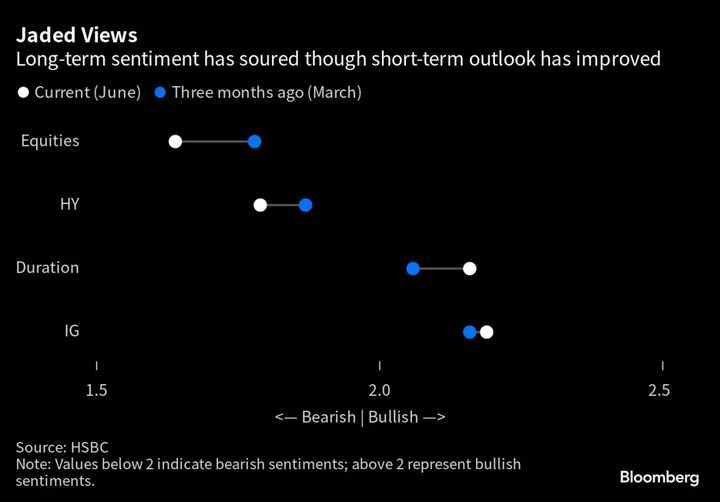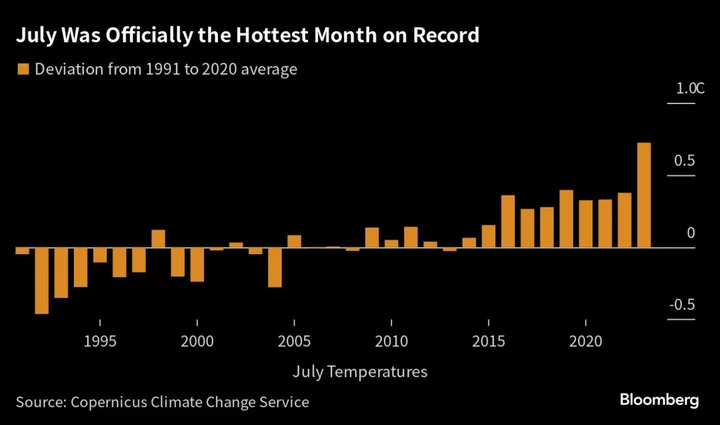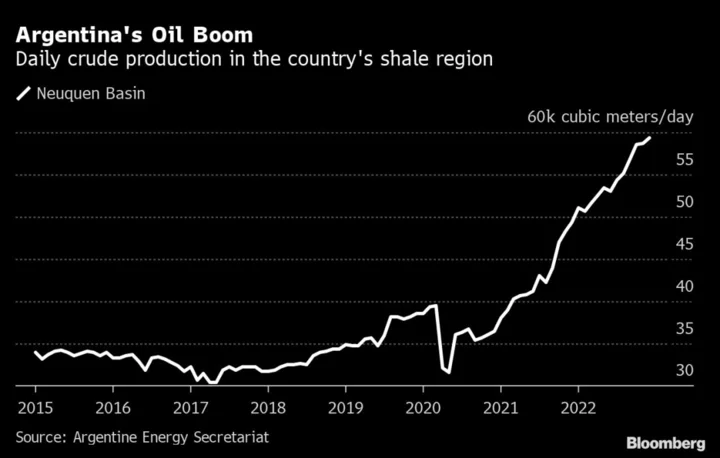Up and down Wall Street, forecasters were caught flat-footed by how the first half of 2023 unfolded in financial markets. That seems to have rattled their faith in what the winning playbook for the rest of it should be. Heading into the year, a handful of predictions dominated strategists’ annual outlooks. A global recession was imminent. Bonds would trounce stocks as equities re-tested bear-market lows. Central banks would soon be able to stop the aggressive rate hikes that made 2022 such a year of market misery. As growth stumbled, there’d be more pain for risky assets. But that bearish outlook was shattered as stocks rallied even as the Federal Reserve continued to ratchet up interest rates in the face of stubbornly elevated inflation. And what was supposed to be the Year of the Bond fizzled: US Treasuries have nearly wiped out their tiny gain for the year as yields test new highs and the economy remains surprisingly resilient in the face of the Fed’s monetary policy onslaught. As a result, financial soothsayers have rarely disagreed more about where markets are headed next. That’s brought into relief by forecasts for where the S&P 500 will end the year: There’s a 50% difference between the most bullish one from Fundstrat (which sees it rising nearly 10% more to 4,825), and the most bearish call from Piper Sandler (down some 27% to 3,225), according to those compiled by Bloomberg. The mid-year gulf hasn’t been that wide in two decades.
Some are now rescinding recommendations or pushing out the timing of their calls. JPMorgan Chase & Co. strategists recently ditched a recommended long position in five-year Treasuries. Those at BlackRock Investment Institute, who suggested a push into investment-grade bonds at the start of the year, now have a neutral view of the sector. At Bank of America Corp. — and elsewhere — the recession once expected for this year has been pushed out as growth holds up stronger than expected.Bespoke co-founder Paul Hickey was among those who weren’t caught completely off guard. In January, he offered a contrarian outlook, saying that the negative consensus among strategists meant that risk assets like stocks may be poised for a rebound. “With consensus being so bearish to kick off the year, rather than needing a positive catalyst to spark a rally, all the market needed was a lack of bad news,” he said. “Whenever we are faced with conflicting messages from the news and the markets, we always defer to the markets.’’After a 37% surge in the Nasdaq 100 Index this year, some strategists have revised their stock-market targets just to account for the equity rally — even if they see modest gains, or declines, for the rest of the year. Goldman Sachs has raised an initial 4,000 year-end target for the S&P 500 to 4,500 after the bank downgraded the odds of recession. It closed just shy of 4,400 Friday. Bank of America, Barclays, BNY Mellon Investment Management, Citigroup, Morgan Stanley and Wells Fargo Investment Institute are among those forecasting it will end the year lower than it is now. BlackRock is betting on the AI boom, even as it continues to warn about the dangers haunting developed-market equities.But even with about a third of the two dozen strategists surveyed by Bloomberg already upgrading their targets and measures of short-term sentiment improved, big investors remain cautious. A survey by HSBC Holdings Plc of the largest 60 asset managers shows they have turned more dour on the long-term outlook, making them even more pessimistic on high-yield bonds and stocks and fueling an even stronger preference for long-duration government debt. At the same time, the average of strategists’ year-end outlooks represents a decline of around 8% in the S&P 500 in the last six months of 2023. That’s the most bearish second-half view since at least 1999.
‘’It's premature to say that the bearish end-of-year calls are truly wrong,’’ said Steve Sosnick, chief strategist at Interactive Brokers. “Being bullish on equities in the face of the sharpest rate hikes in a generation alongside persistent quantitative tightening flies in the face of that logic.’’From a contrarian point of view, the persisting pessimism can be framed as a good sign for risk assets, since that suggests unspent buying power that could push stocks higher when it’s plowed back into the market and bears finally give in. That’s what has happened all year, when defensively positioned investors were under pressure to chase gains.
One thing is for sure, while some bears are sticking to their guns, the few bulls from the start of the year are getting more bullish. Fundstrat’s Tom Lee, who already had the highest year-end forecast for the S&P 500, has boosted his estimate further to 4,825. Meanwhile, Ed Yardeni, founder of his namesake research firm, who was calling for a soft landing at the end of last year, says the worst may be behind and the economy may already be accelerating.“Our ‘rolling recession’ is turning into a ‘rolling expansion’,” Yardeni said. “The pessimists were putting a lot of weight to the tightening of the monetary policy. They kept waiting for a recession and just like Godot, it just didn’t show up.”
Here's a sampling of what some of the biggest names are telling clients:Bank of AmericaThe bank has revised higher its target for US stocks and predicts a later and milder recession in the US.
Barclays ResearchThe firm has given up on their preference for bonds over stocks and sees milder economic contraction in the US.
BlackRock Investment InstituteThe world’s largest asset manager has just introduced a bullish call on AI while remaining cautious on developed market stocks.
BNY Mellon Investment ManagementThe firm is seeing higher chances of recession and higher price pressures than previously forecasted.
CitiThe bank has maintained a US stocks target that suggest losses in the second half and sees a US recession in 2024.
JPMorganThe bank is currently forecasting weakness for equities in the second half of the year amid challenging macro backdrop.
Morgan Stanley
The bank sees the US and Europe avoiding a recession but sees no gains for US stocks through June 2024.
Wells Fargo Investment InstituteIt is pushing its recession forecast later and has lowered its target range of returns for US stocks.
Author: Denitsa Tsekova, Carly Wanna and Lu Wang









